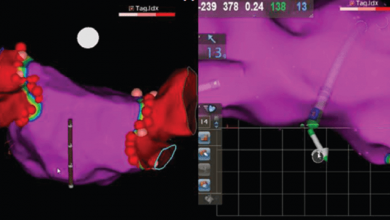Search results
Author(s):
Peter Weiss
Added:
5 years ago
Dr Peter Weiss discusses robotic magnetic navigation. Filmed by Radcliffe Cardiology on-site at HRS 2018 in Boston, US.
View more
Author(s):
Irina Suman-Horduna
,
Sonya Babu-Narayan
,
Sabine Ernst
Added:
3 years ago
Catheter ablation has moved from ablation of ‘simple’ substrates like accessory pathways,1 atrioventricular nodal re-entrant tachycardias (AVNRTs)2 and re-entrant or focal tachycardia (of either ventricular or atrial origin)3–5 in recent years to more complex arrhythmias such as atrial or ventricular tachycardia (VT) or fibrillation.6–8 Even patients with complex congenital heart disease that may…
View more
Sabine Ernst
Research Area(s) / Expertise:
Job title: Consultant Cardiologist
Author
Author(s):
David Filgueiras-Rama
,
Jose L Merino
Added:
3 years ago
Atrial fibrillation (AF) is the most common sustained arrhythmia in the clinical practice.1 The prevalence of the arrhythmia is progressively increasing in developed countries and moreover, it is expected to affect up to 12 million people only in the US by 2050.2 Antiarrhythmic drugs continue to represent the first-line of treatment in AF patients, either to restore sinus rhythm or to prevent…
View more
Author(s):
Rodrigo Gallardo Lobo
,
Michael Griffith
,
Joseph De Bono
Added:
3 years ago
Around 0.8% of live births are affected by some type of congenital heart disease; 30–50% of whom will need one or more surgical interventions, generally during early childhood, involving in some cases complex corrections with patches, baffles or extracardiac circuits.1,2
As a result of advances in surgical interventions, the life expectancy of patients with congenital heart disease has…
View more
Author(s):
Charlotte Brouwer
,
Mark G Hazekamp
,
Katja Zeppenfeld
Added:
3 years ago
The reported incidence of congenital heart disease (CHD) depends on the number of trivial lesions included, such as atrial and ventricular septal defects (ASDs and VSDs). Moderate-to-severe CHD numbers remain stable with 6 per 1,000 live births.1 Survival into adulthood has improved dramatically over the last 25 years and has been driven mainly by a decreased mortality in moderate and severe…
View more
Author(s):
Saagar Mahida
,
Benjamin Berte
,
Seigo Yamashita
,
et al
Added:
3 years ago
Since the first catheter ablation for cardiac arrhythmia more than three decades ago, ablation technology has continually evolved at a rapid pace. Much of the early progress in the field was made in ablation of supraventricular tachycardias. Following a seminal study from Haïssaguerre et al.1 in 1998, which demonstrated that pulmonary vein triggers are important sources of atrial fibrillation (AF…
View more
Author(s):
Marwan M Refaat
,
Jad Ballout
,
Moussa Mansour
Added:
3 years ago
Although there is no formal database of adults with congenital heart disease (CHD) in the United States, the prevalence and incidence of CHD can be estimated and extrapolated from data in the Canadian providence.1 As such, the prevalence of CHD in the United States has been estimated in 2010 to be around 2.4 million people (1.4 million adults and 1 million children), with an incidence of between…
View more
Author(s):
Kenichiro Yamagata
,
Bashar Aldhoon
,
Josef Kautzner
Added:
3 years ago
The number of catheter ablations for atrial fibrillation (AF) treatment has gradually increased over the last 15 years since the first report on the importance of pulmonary vein (PV) foci for triggering AF.1 Catheter ablation for AF is a complex procedure with multiple steps, such as transseptal puncture, mapping of the left atrium and PVs and extensive linear ablation around PV ostia. Not…
View more
Zero X-ray Ablation
Author(s):
Giuseppe Mascia
,
Marzia Giaccardi
Added:
3 years ago
Article













